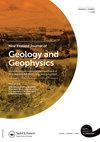Roger Cooper: paleobiologist and geologist
IF 1.9
4区 地球科学
Q1 GEOLOGY
New Zealand Journal of Geology and Geophysics
Pub Date : 2023-07-03
DOI:10.1080/00288306.2023.2236308
引用次数: 0
Abstract
Roger Cooper (1939–2020) was one of the pre-eminent New Zealand paleontologists and geologists of the twentieth century. As with many scientists of his generation, he developed a broad suite of skills and his research ranged widely – a testament to his talents but also a function of the small number of Earth scientists studying New Zealand’s complex geology. Although he always understood that science builds on a foundation of careful observation and description – and he made huge contributions in this regard – he also sought and applied innovative analytical approaches. Roger was open, kind and generous as a mentor, colleague, collaborator and manager. The present collection of papers pays homage to the many ways that Roger’s research advanced understanding of Zealandia’s geological history and wider questions in paleobiology, and several of these papers are written by people whose careers were enriched by their interactions with Roger. Accurate and precise field observation underpins much of Earth science. Roger knew this, but for him field work was also an opportunity to rejuvenate mind and body and immerse himself in the living world; his joy of life always shone brightest when he was in the field. As a second-year geology undergraduate student at Victoria University of Wellington, he was fortunate to join Gerald Lensen of the New Zealand Geological Survey (now GNS Science) for a threemonth expedition to produce a geological map of the Clarence valley area in the South Island (Lensen 1962). The field work was challenging but hugely educational for Roger; in his own, understated words, ‘I was a pretty raw second year student when we started and learned a lot from the experience’ (Roger Cooper, written pers. comm. 2017; see obituary by Crampton, Beu, et al. 2020a). The paper herein by Crampton (2023) revisits the geology of the northern Clarence valley area, covering a small part of the territory mapped by Roger, and uses new observations of field relationships to interpret the Cretaceous tectonostratigraphic history; these new data bear on the contentious issue of exactly when Mesozoic subduction terminated on the margin of Gondwana. By the time he had finished his PhD, supervised by Harold Wellman, Roger had completed field seasons in the Antarctic, Otago, Southland, and the Golden Bay area, and had spent 18 months on the island of Borneo (Crampton, Beu, et al. 2020). His growing family joined him for field work in the Golden Bay area, based in Magnesite Hut in the Cobb valley. Helicopter trips to remote ridges, caves full of moa bones, and mountain lakes and streams kept children happy and formed their long-lasting affinities with the New Zealand bush and upland country. Roger’s Borneo jungle experience equipped him with a range of distinctive long-distance bush communication calls, his faithful parang (a type of machete made from a car leaf spring), and the ability to make a fire under any conditions, all of which translated well to New Zealand fieldwork. He would return from each long day to apply methylated spirits liberally to sunburns and indulge in a glass of Old Moutere cider with colleagues and students. His son Alan recalls numerous stops to inspect road cuttings, made worthwhile by the barely suppressed excitement when things like corals were discovered unexpectedly in Upper Ordovician sandstone (on the Cobb valley road), and this, in turn, led to Alan’s own passion for field-based science. Roger’s career at the New Zealand Geological Survey began in 1969 and was focussed initially on the taxonomy, biostratigraphy, evolution, biogeography and paleobiology of early Paleozoic fossils in New Zealand. Much of this research was concerned with graptolites (e.g. Cooper 1973, 1979a; Cooper and McLaurin 1974) but, in collaboration with others, his interests quickly expanded to include conodonts, brachiopods, molluscs, trilobites and graptolites from New Zealand, Australia, Antarctica and Spitsbergen (e.g. Cooper and Druce 1975; Shergold et al. 1976). One hallmark of Roger’s career was the lifelong collaborations and friendships he developed with scientists around the world. An early example罗杰·库珀:古生物学家和地质学家
罗杰·库珀(1939-2020)是20世纪新西兰最杰出的古生物学家和地质学家之一。和他那一代的许多科学家一样,他发展了一套广泛的技能,他的研究范围也很广——这是他才华的证明,但也是为数不多的研究新西兰复杂地质的地球科学家的作用。尽管他始终明白科学建立在仔细观察和描述的基础上——他在这方面做出了巨大贡献——但他也寻求并应用了创新的分析方法。作为导师、同事、合作者和经理,罗杰是开放、善良和慷慨的。本书收录的论文从多方面向罗杰的研究致敬,这些研究促进了人们对西兰迪亚地质历史和更广泛的古生物学问题的理解,其中一些论文的作者因与罗杰的互动而丰富了他们的事业。精确的野外观测是地球科学的基础。罗杰知道这一点,但对他来说,野外工作也是一个恢复身心活力、让自己沉浸在现实世界中的机会;当他在田间时,他的生活乐趣总是闪耀着最耀眼的光芒。作为惠灵顿维多利亚大学地质学本科二年级的学生,他很幸运地加入了新西兰地质调查局(现在的GNS科学)的Gerald Lensen,进行了为期三个月的考察,绘制了南岛克拉伦斯山谷地区的地质图(Lensen 1962)。实地工作很有挑战性,但对罗杰来说很有教育意义;用他自己轻描淡写的话说,刚开始的时候,我是一个非常不成熟的二年级学生,从这次经历中学到了很多东西。通讯。2017;参见Crampton, Beu等人的讣告。2020a)。Crampton(2023)的论文重新审视了克拉伦斯河谷北部地区的地质情况,覆盖了Roger绘制的一小部分领土,并使用新的野外关系观测来解释白垩纪构造地层历史;这些新资料对中生代俯冲作用何时终止于冈瓦纳边缘这一有争议的问题产生了影响。在Harold Wellman的指导下完成博士学位时,Roger已经完成了在南极、奥塔哥、南地和金湾地区的实地考察,并在婆罗洲岛度过了18个月(Crampton, Beu, et al. 2020)。他不断壮大的家庭加入了他在金湾地区的实地工作,总部设在科布山谷的菱镁矿小屋。乘坐直升机前往偏远的山脊、满是恐鸟骨头的洞穴、山上的湖泊和溪流,让孩子们感到快乐,并与新西兰的丛林和高地国家形成了长期的亲密关系。罗杰在婆罗洲丛林的经历使他具备了一系列独特的远距离丛林交流呼叫,他忠实的parang(一种由汽车钢板弹簧制成的弯刀),以及在任何条件下生火的能力,所有这些都很好地转化为新西兰的野外工作。每天结束漫长的一天后,他会在晒伤处大量涂抹甲基化烈酒,并与同事和学生一起畅饮一杯老穆泰尔苹果酒。他的儿子艾伦回忆说,他曾多次停下来检查道路切割,当他在上奥陶世的砂岩中(在科布山谷的路上)意外地发现了珊瑚之类的东西时,他几乎无法抑制自己的兴奋,这让他觉得很有价值,这也激发了艾伦对实地科学的热情。罗杰在新西兰地质调查局的职业生涯始于1969年,最初专注于新西兰早期古生代化石的分类学、生物地层学、进化、生物地理学和古生物学。这些研究大多与笔石有关(如Cooper 1973,1979a;但在与其他人的合作下,他的兴趣迅速扩大到包括来自新西兰、澳大利亚、南极洲和斯匹次卑尔根岛的牙形刺、腕足动物、软体动物、三叶虫和笔石(例如Cooper and Druce 1975;Shergold et al. 1976)。罗杰职业生涯的一个标志是他与世界各地的科学家建立了终生的合作和友谊。一个早期的例子
本文章由计算机程序翻译,如有差异,请以英文原文为准。
求助全文
约1分钟内获得全文
求助全文
来源期刊
CiteScore
5.10
自引率
27.30%
发文量
34
审稿时长
>12 weeks
期刊介绍:
Aims: New Zealand is well respected for its growing research activity in the geosciences, particularly in circum-Pacific earth science. The New Zealand Journal of Geology and Geophysics plays an important role in disseminating field-based, experimental, and theoretical research to geoscientists with interests both within and beyond the circum-Pacific. Scope of submissions: The New Zealand Journal of Geology and Geophysics publishes original research papers, review papers, short communications and letters. We welcome submissions on all aspects of the earth sciences relevant to New Zealand, the Pacific Rim, and Antarctica. The subject matter includes geology, geophysics, physical geography and pedology.

 求助内容:
求助内容: 应助结果提醒方式:
应助结果提醒方式:


